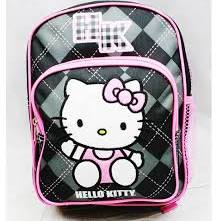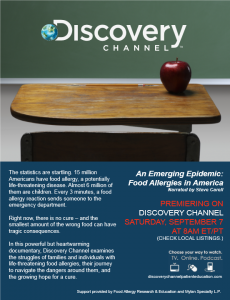We wanted to share with you what you needed for a Food Allergy Medical Bag, or a Medical Bag for someone with Anaphylaxis.
Your allergist will likely prescribe an EpiPen® Jr. for your child if your child has experienced anaphylaxis, child has scored very high, 4+, on a skin prick allergy test or Immunocap RAST blood test to a specific substance or is believed to be likely to experience anaphylaxis in the future. The EpiPen® Jr is very lightweight, one pen contains one dose (.15 mg) of epinephrine for a child. Once your child reaches 60+ pounds they will go to the EpiPen® rather than the Jr.
EpiPen® should stay out of direct sunlight, do not leave it in a car/truck and do not put in refrigerator. Always replace your EpiPen® once it expires. You can find the Expiration Date on the EpiPen®

Example of a Medical Mini Bookbag
Everything you need in Medical Bag
1. Mini Bookbag
~very convient to carry to school, or on a bus.
2. Take Medications
~ EpiPen 2-Pak® , always have more than 1, in case one misfires/malfunctions, Benadryl®, Inhaler, and the Allergy Form
3. Write all Contacts on an index card
~Place with the Allergy Form, you can never have too many contact copies
Be sure to take the bag with you everywhere. Georgia has released that Anaphylaxis students can now carry their medications with them. I personally think this is a great way to make sure the student has their medications with them: in a class, lunch, bus. No more looking for their medications if it is always on the student. If the student has a substitute bus driver, the medication is still on the student, so no more worries about getting the medications handed off.
When the student is carrying their medications be sure to let the child know, the medicine they are carrying they should not be showing it off or playing with it, it is not for play. It is for Emergency Use Only!
Reaction for when to use EpiPen®:
(The optimum time to administer the EpiPen® is within 15 minutes; however allergic reactions can progress much quicker)
- Hives
- Swelling of the throat continuing down to the lungs
- Vomiting/diarrhea
- Difficulty breathing
If EpiPen® is used, give Benadryl® and call 911, let them know the child has went into anaphylatic shock. Once the child arrives at the hospital, the child will need to remain there for 4 to 8 hours because the shock could return called biphasic reaction.
Related articles
- Keep a set of Epi Pens in your child’s backpack! (onehungrybear.wordpress.com)

 Viewers can watch the show online at
Viewers can watch the show online at